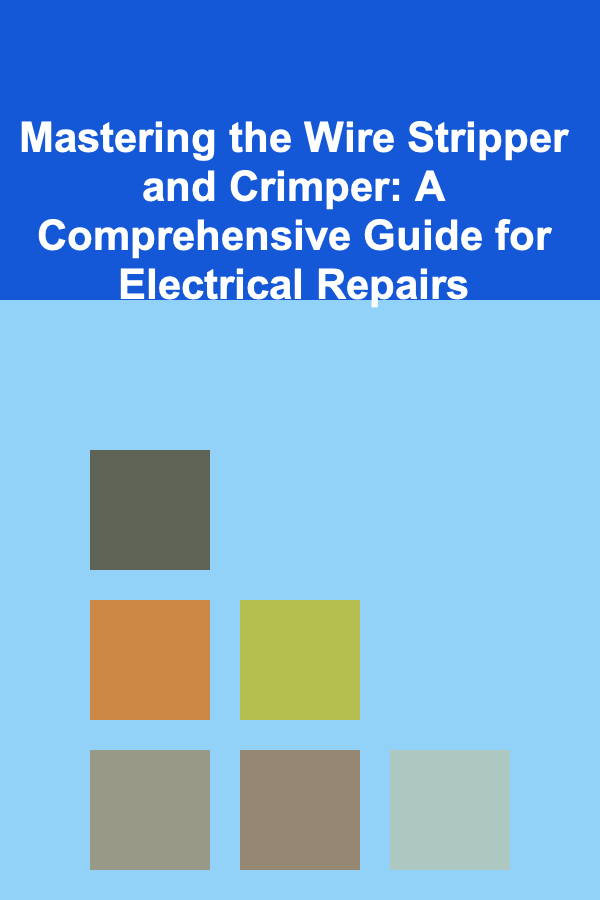
How to Crochet Celtic Knot Patterns
ebook include PDF & Audio bundle (Micro Guide)
$12.99$11.99
Limited Time Offer! Order within the next:
Not available at this time

Crocheting Celtic knot patterns is an intricate and beautiful way to combine traditional craft with a modern aesthetic. The allure of Celtic knots lies in their endless loops and interwoven forms, representing unity, eternity, and continuity. These patterns are not just visually striking; they carry deep symbolism and are historically significant in cultures such as Irish, Scottish, and Norse traditions.
In this article, we'll explore the fascinating world of crocheting Celtic knot patterns. We'll go over the essential techniques, tips for beginners, different types of Celtic knot patterns, and detailed instructions for making your very own designs.
The Significance of Celtic Knots
Celtic knots, also known as endless knots or mystic knots, are designs that consist of loops, spirals, and interwoven paths. They are commonly associated with Celtic artwork, from ancient manuscripts like the Book of Kells to modern-day jewelry and home décor. These knots often have no clear beginning or end, symbolizing eternity, interconnectedness, and the cyclical nature of life. In crochet, these motifs provide both a challenge and an opportunity for creativity, as they require a steady hand and patience to master.
In addition to their aesthetic value, Celtic knots have cultural and spiritual meanings. They represent the continuous flow of life, the connection between the earthly and the divine, and the union of opposites. Creating Celtic knots through crochet is a way to connect with a rich artistic heritage while expressing personal creativity.
Basic Crochet Skills for Celtic Knots
Before diving into specific Celtic knot patterns, it's important to review the basic crochet skills that will help you achieve clean and precise results. While some Celtic knot designs may seem complicated at first, many can be created with a few basic crochet stitches.
Essential Stitches for Celtic Knot Patterns:
- Chain (ch): The foundation of most crochet patterns, forming the starting point of your work.
- Slip Stitch (sl st): Used to join stitches or move across stitches without adding height.
- Single Crochet (sc): A basic stitch that creates a dense, textured fabric.
- Double Crochet (dc): A taller stitch that gives more drape and flexibility to the fabric.
- Half Double Crochet (hdc): A hybrid stitch that is between a single and double crochet in height.
- Treble Crochet (tr): A tall stitch that creates an open and airy fabric.
These stitches will serve as the building blocks for creating interwoven Celtic knot designs.
Understanding Tension:
When crocheting Celtic knots, it's important to maintain a consistent tension throughout the piece. This ensures that the loops and intersections of the knots look even and balanced. If your tension is too tight, the knot may appear squished and uneven, while loose tension can cause the design to lose its definition. Practice adjusting your tension until it feels comfortable and consistent.
Choosing Yarn and Hook Size
Celtic knot patterns typically work well with a variety of yarn types, but the best yarn will depend on the desired outcome. If you're aiming for intricate, delicate knots, a thinner yarn such as lace-weight or fingering weight yarn will give you a finer, more detailed look. If you prefer a chunkier, more textured appearance, opt for a thicker yarn such as worsted weight.
Recommended Yarn Types:
- Cotton yarn: This is great for crisp, defined stitches and a more structured look. It's particularly useful for home décor projects like wall hangings or coasters.
- Wool yarn: Wool is soft and elastic, making it a good option for cozy, drapey knots in garments and accessories.
- Acrylic yarn: If you're looking for durability and ease of care, acrylic is a versatile yarn for Celtic knot patterns, especially for beginners.
For hook size, it's essential to match the size of the hook to the yarn. Typically, a hook that's one size smaller than the yarn's recommended size will create denser, tighter knots, which is often preferred for Celtic patterns.
Creating Basic Celtic Knot Design
While there are many complex and intricate Celtic knot patterns, many can be started with a simple loop-based design. Below is a guide to help you create your first basic Celtic knot.
Materials Needed:
- Yarn of your choice (medium weight yarn recommended for beginners)
- Crochet hook (appropriate for your yarn weight)
- Scissors
- Yarn needle (for weaving in ends)
Instructions:
- Start with a foundation chain: Create a foundation chain of a length that will serve as the base of your knot. For a basic knot, chain 30 stitches.
- Make the first loop: Turn your work and create the first loop by crocheting into the second chain from the hook. Work a series of single or double crochet stitches, depending on the desired tightness of the loop. This loop will form the first part of the knot.
- Create the second loop: To form the second loop, work another row of stitches on the opposite side of the first loop. You can use the same technique as before, making sure the stitches are even and aligned.
- Join the loops: Once you have two loops, overlap them and join them at the center with a slip stitch or single crochet stitch. This is where the interwoven effect begins.
- Repeat for additional loops: To create a more intricate design, you can repeat the process of creating loops, adjusting the direction and positioning to form a pattern. For example, you might form three or four loops that intersect with each other in a symmetrical, interwoven design.
- Finish off: Once you are satisfied with your knot pattern, fasten off the yarn, leaving a long tail. Use a yarn needle to weave in any loose ends.
Tips:
- Work with even tension: Consistent tension ensures that each loop is uniform and crisp.
- Try different stitch combinations: Experiment with different crochet stitches (e.g., treble crochet or half-double crochet) to add texture and variation to the knot design.
- Practice shaping: If you're making a more complex design, such as a traditional square Celtic knot, focus on the precise placement of each loop to ensure the pattern aligns symmetrically.
Advanced Celtic Knot Patterns
Once you've mastered the basics, you can move on to more intricate and advanced Celtic knot patterns. These designs involve several loops and intersecting paths that create a dynamic, complex appearance. Here are a few common advanced Celtic knot designs to try:
1. Square Celtic Knot
The square Celtic knot is one of the most traditional designs, often used in jewelry, tattoos, and other forms of artwork. It consists of four loops arranged in a square shape, with each loop weaving over and under the others.
Instructions:
- Begin by crocheting four separate loops using a chain and single crochet stitches.
- Arrange the loops to form a square, ensuring the loops are intertwined correctly.
- Join the loops at each intersection using slip stitches or single crochet stitches.
2. Endless Knot
The endless knot, also called the mystic knot, is one of the most recognized Celtic designs. It represents the concept of infinity, with the lines never breaking and constantly flowing.
Instructions:
- Start with a foundation chain, and form a series of interconnected loops, making sure to keep the tension tight for clear definition.
- Carefully plan the intersections so that they create a continuous flow with no breaks in the design.
3. Heart-Shaped Celtic Knot
A heart-shaped Celtic knot is a popular variation used for romantic designs or themed projects like Valentine's Day crafts or wedding decorations.
Instructions:
- Begin with a small loop at the top of the heart, then crochet two larger loops beneath it, forming the bottom curves of the heart.
- Weave the loops together at the center and the edges to maintain the heart shape.
4. Celtic Cross Knot
This design combines the traditional cross shape with interwoven Celtic knots. It's often seen in religious artifacts and symbolic artwork.
Instructions:
- Start with a central loop, then form horizontal and vertical loops around it to create the cross shape.
- Ensure the intersections create the signature Celtic weave by alternating over-and-under stitches.
Common Mistakes and How to Avoid Them
Crocheting Celtic knots requires patience and attention to detail, but beginners may encounter a few challenges along the way. Here are some common mistakes and tips to help avoid them:
- Inconsistent Tension: Uneven tension can make the knots look uneven or lopsided. Practice controlling your tension to create clean, even loops.
- Skipping Intersections: Be mindful of the placement of your loops and intersections. Skipping or incorrectly positioning loops can break the flow of the knot.
- Misaligned Loops: Make sure that your loops are evenly spaced and that their intersections align symmetrically.
- Incorrect Stitch Count: Always check that you have the correct stitch count before joining the loops. Having the right number of stitches in each loop ensures that the pattern flows correctly.
Conclusion
Crocheting Celtic knot patterns is a rewarding and creative craft that combines artistry with skill. By understanding the techniques, materials, and symbolism behind Celtic knots, you can create beautiful, intricate designs that carry both personal and cultural significance. Whether you're a beginner or an experienced crocheter, mastering these patterns opens up endless possibilities for stunning crochet projects, from decorative items to wearable accessories. By following the steps, tips, and instructions outlined in this guide, you'll be well on your way to creating your very own Celtic knot creations. Happy crocheting!

How to Perform Routine Electrical Inspections for Safety
Read More
How to Run LinkedIn Polls and Surveys to Understand Your B2B Dropshipping Audience
Read More
Navigating the World as a Travel Agent: Tips, Tricks, and Tales from the Frontline
Read More
How to Understand the Social Impact of Augmented Reality (AR)
Read More
Raising Good Humans: Kindness, Confidence, and Connection
Read More
Mastering the Wire Stripper and Crimper: A Comprehensive Guide for Electrical Repairs
Read MoreOther Products

How to Perform Routine Electrical Inspections for Safety
Read More
How to Run LinkedIn Polls and Surveys to Understand Your B2B Dropshipping Audience
Read More
Navigating the World as a Travel Agent: Tips, Tricks, and Tales from the Frontline
Read More
How to Understand the Social Impact of Augmented Reality (AR)
Read More
Raising Good Humans: Kindness, Confidence, and Connection
Read More